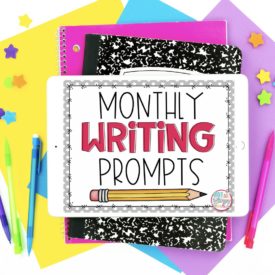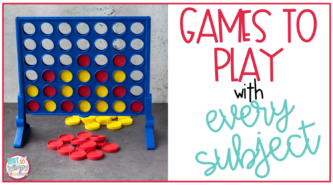
Today’s post is a good one! We are talking about things you don’t have to grade. #yourewelcome
Many teachers in my Facebook groups say grading is their least favorite part of teaching. And I get it. I didn’t like grading either. Mostly because it takes so darn long. And grading twenty-four of the same papers can make your eyes go blurry.
But grading is a necessary and important part of teaching, so over time I came up with strategies to make this task easier. My favorite strategy was the easiest–just grade less. I did not grade every assignment my students turned in. And you don’t have to either.
Today I’m sharing 3 specific things you don’t have to grade.
Why grades are important
First, let’s chat for a minute about why grades are important. As long as there are teachers, there will be a debate over whether or not grades are really necessary. Some people believe that grades reduce intrinsic motivation because instead of learning for learning’s sake, kids only learn so they can perform well on tests and receive good grades or praise.
Others worry that grades can lower children’s self-esteem and make them feel bad about themselves. When students exert a lot of effort and still do poorly, they may feel disappointed, frustrated, or hopeless. They may begin to believe that they are dumb and that they will never do well in school.
I think it’s important that we communicate with kids what grades are (and what they aren’t). Grades are not a measure of worth or success. They don’t tell us who is a good student or a bad student. They are simply a snapshot of a student’s mastery of material at one point in time.
Grades are important because they provide a measure of student progress. We want to be able to assess how much our students grow over the course of a unit or year, and grades give us an objective way of doing that.
Grades are also a great communication tool. They let both parents and students know which areas students have mastered, and which still need some practice.
The trouble with grading
There are a couple of reasons that teachers don’t like grading. The first one is that it can feel very subjective and arbitrary, especially if you are grading creative assignments. Teachers sometimes say they don’t know what is an A assignment versus a B assignment. Or that they will start grading and give something a C, and then realize that no one met all their expectations and so they have to go back and re-grade everyone’s work.
To combat this, I recommend using a rubric whenever you have a subjective assignment. The rubric clearly defines the criteria and expectations for each level of mastery. It helps students perform better on assignments, and makes it much easier to grade. Check out my blog post here to read more about using rubrics to teach writing. A rubric makes grading a much easier, and more comfortable, task.
The other problem with grading is that it is very time-consuming. Think about it, you’re teaching between five and seven subjects every day. Even if you only have one assignment in each subject, that’s more than twenty-five assignments per week. Multiply by that twenty, thirty, or in some cases more for each of the students you have in your class, and that’s a lot of grading. And then there’s homework and centers and morning work . . .
And if you’re lucky you get one plan period today. There’s no way you can do all of your planning, prepping, and grading in that one forty-minute block. If you try to grade every assignment your students complete, you could literally spend all your spare time grading and still not catch up.
Luckily, you DON’T HAVE TO GRADE EVERY ASSIGNMENT.
3 things you don’t have to grade
Practice sheets
During the course of a week, your students will complete many practice pages. This is a great way for them to apply new skills and helps them understand new material.
Practice pages can help you check for understanding. And they can serve as a great reference for homework or as study tools. But you don’t have to grade practice pages.
When students complete these practice pages, they do not yet know this material. The entire point of these assignments is to practice something new. It’s even right in the name of the assignment.
Grading kids on brand-new skills is not effective or fair. Sure, some kids will pick up something on the first try, but others will need repeated lessons, reteaches, and practice pages before it clicks. There’s no point in grading practice pages because they don’t tell us anything.
Homework
Homework, ugh! I could write an entire post about homework. But for now, let me just say that you do not need to grade homework.
If you assign homework (and I know that many schools require it), please do not waste your time grading it.
The purpose of homework is the same as practice pages–it gives students extra practice with new skills to help them solidify new concepts. Homework is almost always related to a lesson that you taught in class that day. That means students are not yet masters of this material. They are just being introduced to it and can not be expected to fully understand it.
Also, you have no idea who actually completed a student’s homework. It’s possible that an older sibling, babysitter, or parent did the assignment. This is even more true if the homework is graded. In an effort to get a good grade on something they don’t yet understand students will quite reasonably ask for help. This means that the grade on the assignment might not actually reflect how much a student knows.
Save yourself a lot of time and headaches and just skip the homework grades.
Exit Tickets
I love exit tickets. They enable you to quickly assess a lesson and get an idea of how well students understand the new material. But, this is just an informal assessment.
Exit tickets are used at the end of a new lesson. This means students have only just been exposed to the material. They have not had much time to practice, much less master the material. So there is no point in grading them.
Before you give an exit ticket, you should remind students that this is not a quiz or graded assignment, it’s simply a reflection of what they understood that day.
It’s easy to assess learning without grading exit tickets. Simply reviewing student responses allows you to easily identify student strengths and weaknesses, and then plan for the next day’s instruction. As you look at individual exit tickets, you can determine:
- How many kids understand the new skill and concept and are ready to move forward?
- How many students still need additional instruction on the material?
- How can you change your lesson plans to meet your students’ needs the next day?
The purpose of exit tickets is to plan future instruction, not evaluate student learning.
How to Love Teaching Again
Want more great tips on how to make grading easier? You need to check out my book How to Love Teaching Again. It’s full of simple, practical strategies just like this to help you defeat burnout, overcome perfectionism, and restore the joy of teaching.

If you liked this post, you’ll love all the time-saving tips inside the book. I share my best strategies for planning your time and your lessons, grading, classroom management, homework, teaching engaging lessons, setting boundaries, and so much more. And each easy-to-read chapter is packed with real-life examples and stories that I know you will relate to.
There’s even a 21-day challenge at the end to help you implement what you learn.
If you want to be among the very first to get your hands on this must-read guide, use the link below to order a copy today.
You’ll also get these three AWESOME bonuses:
- Book Club Kit: Want to host a book club at your school? This Book Club Kit includes a calendar of events, suggested reading schedule, reflection questions, and tips for implementing the most important strategies in each chapter!
- Yearlong Pacing Guides for grades 2-5: If you teach grades 2-5, you can just download and go! If not, these are great examples of how to create your own yearlong pacing guide and save yourself a ton of stress and time. Either way, they are pure gold.
- Editable Sub Plan Templates: From daily schedule to lesson plan template to classroom behavior plan and more, these templates include everything you need to plan for a sub without breaking a sweat. (In both digital and printable formats!) And the great thing is, most of these pages can be done in advance. So when you need to take a day off, you’ve got everything all ready to go!

I hope these tips save you some time grading!
Have a Not So Wimpy Day,


















 End of Year Carnival Week for grades 2-5!
End of Year Carnival Week for grades 2-5!
Leave a Comment